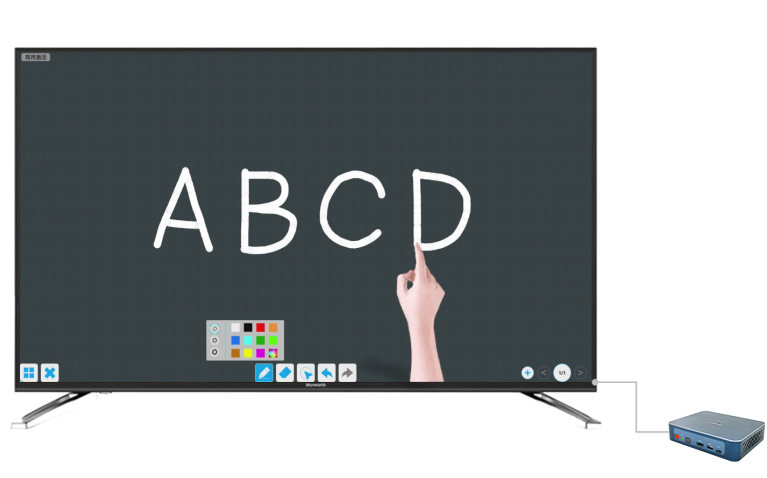Multimedia classrooms and smart classrooms are very important teaching environments in modern education, both of which have their own characteristics and advantages, but at the same time, there are also some differences and connections. Below, we will provide a detailed introduction to the concepts, functions, differences, and connections between the two, to help everyone better understand their essence.
- Concept: A multimedia classroom is a teaching environment based on multimedia devices. It integrates various forms of information such as text, images, and sound through devices such as computers, projectors, and sound systems, achieving interactive teaching methods.
- Function: The main functions of multimedia classrooms include:
(1) Display multimedia content: By using projectors, large screen TVs, computers, and other devices, various forms of teaching content such as PPTs, images, and videos are displayed to improve teaching effectiveness.
(2) Implement interactive teaching: Through devices such as computers and physical display platforms, achieve interaction with students, enhance their learning interest and participation.
(3) Provide multiple teaching tools: The multimedia classroom is equipped with various teaching tools, such as PPT remote control, electronic whiteboard, etc., to facilitate teachers in teaching.
For example, Bijie Multimedia Classroom Solution can provide various functions such as whiteboard annotation, information publishing, screen mirroring and control, and group streaming.

- Advantages: The advantages of multimedia classrooms lie in:
(1) Diverse forms of information: Multimedia classrooms can integrate various forms of information together, making teaching content more vivid and vivid, and improving students’ interest and participation in learning.
(2) Interactive teaching: Multimedia classrooms can achieve interaction with students, improve their learning effectiveness and participation.
(3) Improving teaching quality: Multimedia classrooms can make teaching more convenient for teachers, improving teaching quality and efficiency.

- Concept: A smart classroom is a teaching environment based on technologies such as the Internet of Things, big data, and artificial intelligence. It achieves intelligent teaching and management through intelligent devices, sensors, and other means.
- Function: The main functions of a smart classroom include:
(1) Intelligent teaching: Through intelligent devices, sensors, and other means, achieve intelligent presentation and management of teaching content, and improve teaching effectiveness.
(2) Data analysis and monitoring: Through big data analysis technology, analyze and monitor the learning behavior and grades of students, providing teachers with more accurate teaching assistance.
(3) Intelligent management and security: Through intelligent management methods, achieve intelligent management and security of classrooms, improve classroom safety and management efficiency.
For example, the Bijie Smart Classroom renovation solution can provide a unified management platform, centralized operation and maintenance, as well as various functions such as RTSP recording and playback interface, API interface, OPS linkage, etc.

- Advantages: The advantages of a smart classroom are:
(1) Intelligent teaching: Smart classrooms can achieve intelligent presentation and management of teaching content, improve teaching effectiveness and learning experience.
(2) Data driven teaching: Through big data analysis technology, teachers can more accurately understand the learning situation and needs of students, and provide personalized teaching plans for each student.
(3) Intelligent management and security: Smart classrooms can achieve intelligent management and security of classrooms, improving classroom safety and management efficiency.
The difference and connection between multimedia classrooms and smart classrooms
- Differences – There are some differences in functionality and characteristics between multimedia classrooms and smart classrooms. Multimedia classrooms mainly emphasize the display of multimedia content and interactive teaching, while smart classrooms place more emphasis on intelligent teaching and data-driven teaching assistance. In addition, smart classrooms also have functions such as intelligent management and security, while multimedia classrooms do not have these functions.
- Connection – Although there are some differences between multimedia classrooms and smart classrooms, there are also some connections between them. Firstly, some intelligent devices and sensors in smart classrooms can also be used for displaying multimedia content and interactive teaching, thereby improving teaching effectiveness and learning experience. Secondly, big data analysis technology in smart classrooms can also analyze and monitor teaching data in multimedia classrooms, providing teachers with more accurate teaching assistance. Therefore, multimedia classrooms and smart classrooms are not independent of each other, but can be integrated with each other. In the future, with the continuous development and application of technology, the connection between the two will become even closer.